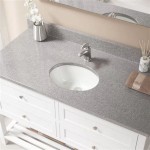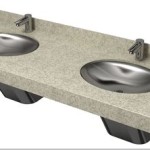Do You Need To Fully Tile A Bathroom?
The question of whether to fully tile a bathroom is a common consideration for homeowners undertaking renovations or new construction. While full tiling offers certain benefits, it's not always a necessary or even the most desirable approach. Understanding the advantages and disadvantages of both full and partial tiling can help inform the decision-making process and lead to a bathroom design that balances aesthetics, functionality, and budget.
Bathrooms, by their very nature, are high-moisture environments. Showers, baths, and sinks contribute to elevated humidity levels, which can promote mold and mildew growth if not properly managed. Materials susceptible to water damage, such as drywall and certain types of paint, can deteriorate over time in these conditions. Tiling, being a waterproof and durable surface, provides a protective barrier against moisture penetration. However, the extent of tiling required to effectively mitigate moisture depends on several factors.
The choice between full and partial tiling often comes down to a trade-off between cost, aesthetics, practicality, and the homeowner's specific needs and preferences. A fully tiled bathroom can create a luxurious and easy-to-clean space, but it also represents a significant investment. Partial tiling, on the other hand, can be a more budget-friendly option that still offers adequate protection against moisture while allowing for the incorporation of other design elements. The following sections will examine key aspects to consider when deciding whether or not to fully tile a bathroom.
Understanding the Benefits of Full Bathroom Tiling
Full bathroom tiling involves covering all wall surfaces, from floor to ceiling, with tiles. This approach offers a number of compelling advantages, primarily related to moisture protection, ease of cleaning, and aesthetic appeal. These advantages merit careful consideration when evaluating bathroom renovation options.
One of the most significant benefits of full tiling is its superior protection against moisture intrusion. By creating a completely sealed barrier, it effectively prevents water from penetrating the walls and causing damage to the underlying structure. This is particularly important in areas directly exposed to water, such as shower enclosures and around bathtubs. Full tiling minimizes the risk of mold and mildew growth, contributing to a healthier and more durable bathroom environment. The grout lines, while requiring occasional maintenance, are generally more resistant to water damage than painted drywall or wallpaper.
Another key advantage of fully tiled bathrooms is their ease of cleaning and maintenance. Tile surfaces are inherently non-porous and resistant to stains, making them simple to wipe down and keep clean. Unlike painted walls, tiles are not susceptible to water stains or discoloration from cleaning products. This ease of maintenance can save time and effort in the long run. Furthermore, the durability of tile ensures that it will maintain its appearance for many years, resisting scratches, chips, and fading.
From an aesthetic perspective, full tiling can create a visually striking and cohesive bathroom design. The seamless expanse of tile lends a sense of luxury and sophistication, particularly when using high-end materials or intricate patterns. Full tiling also provides a blank canvas for incorporating various design elements, such as accent tiles, decorative borders, and contrasting grout colors. The uniformity of the tile can also create a sense of spaciousness, especially in smaller bathrooms. Furthermore, the enduring style of tile means that a fully tiled bathroom will likely remain visually appealing for a considerable time.
Exploring Alternatives to Full Bathroom Tiling: Partial Tiling and Other Moisture-Resistant Materials
While full bathroom tiling offers significant benefits, it's crucial to acknowledge alternative approaches that balance cost, aesthetics, and functionality. Partial tiling, combined with the strategic use of moisture-resistant materials, can be a viable and often more economical solution for many bathrooms. Understanding these alternatives can lead to a more tailored and budget-conscious renovation project.
Partial tiling typically involves tiling only the areas of the bathroom most susceptible to water exposure, such as the shower enclosure, the wall behind the bathtub, and the backsplash behind the sink. The remaining wall surfaces can then be finished with other materials, such as moisture-resistant paint or wallpaper specifically designed for bathroom use. This approach reduces the overall cost of the tiling project while still providing adequate protection against moisture in the areas where it is most needed. The key is to carefully select and apply materials that can withstand the humid conditions of a bathroom environment.
Moisture-resistant paints are formulated to repel water and resist mold and mildew growth. These paints typically contain additives that inhibit the growth of microorganisms and provide a protective barrier against moisture penetration. When preparing the walls for painting, it's essential to use a primer designed for bathrooms to further enhance moisture resistance. Proper ventilation is also crucial, as it helps to reduce humidity levels and prevent moisture buildup. Consider installing or upgrading the bathroom exhaust fan to ensure adequate airflow.
Another alternative to full tiling is the use of waterproof wall panels made from materials such as PVC or acrylic. These panels are designed to be easily installed and provide a seamless, waterproof surface. They are available in a variety of colors and patterns, mimicking the look of tile or other natural materials. Wall panels can be a cost-effective and low-maintenance option for bathrooms, offering a modern and clean aesthetic. In addition to these, there are various wallpapers now manufactured to be water-resistant, offering a range of textures and styles that can be more economical than comprehensive tiling.
Factors to Consider When Making the Decision
The decision of whether to fully tile a bathroom should be based on a careful assessment of various factors, including budget, lifestyle, aesthetic preferences, and the specific characteristics of the bathroom space. A comprehensive evaluation of these factors will ensure that you choose the most appropriate and cost-effective solution for your needs.
Budget is often a primary consideration when planning a bathroom renovation. Full tiling can be a significant expense, particularly if using high-end tiles or hiring professional installers. Partial tiling, combined with the use of less expensive materials like moisture-resistant paint, can significantly reduce the overall cost of the project. It's important to obtain multiple quotes from contractors and compare the cost of different tiling options and materials. Also, consider the long-term cost savings associated with full tiling, such as reduced maintenance and increased durability.
Lifestyle and personal preferences also play a crucial role in the decision-making process. If you prioritize low maintenance and ease of cleaning, a fully tiled bathroom may be the best option. If you prefer a more textured and visually diverse space, partial tiling combined with other materials may be more appealing. Consider your personal aesthetic preferences and how the tiling will complement the overall design of your home. Also, think about your lifestyle and how often you use the bathroom. If you have a large family or use the bathroom frequently, a fully tiled space may be more durable and easier to maintain.
The size and layout of the bathroom are also important factors to consider. In smaller bathrooms, full tiling can create a sense of spaciousness and uniformity. In larger bathrooms, partial tiling can be used to create visual interest and define different zones. The specific characteristics of the bathroom space, such as the presence of windows or other architectural features, should also be taken into account. Consider the existing ventilation system and whether it is adequate to prevent moisture buildup. If you live in a humid climate, full tiling may be a more prudent option to protect against moisture damage.
Ultimately, the choice between full and partial bathroom tiling is a personal one that depends on your individual needs, preferences, and budget. By carefully considering the factors outlined above, you can make an informed decision that will result in a bathroom that is both functional and aesthetically pleasing.

How Much Of Your Bathroom Should You Tile

How Much Of Your Bathroom Should You Tile

Half Tiled Vs Fully Bathroom Pros Cons Things To Consider

Half Tiled Vs Fully Bathroom Pros Cons Things To Consider

How Much Of Your Bathroom Should You Tile

Should Bathroom Be Fully Tiled Homenish

Half Tiled Vs Fully Bathroom Pros And Cons Porcelanosa

Should Bathroom Be Fully Tiled Homenish

How Much Of Your Bathroom Should You Tile

Half Tiled Or Fully Bathroom Walls Guru







